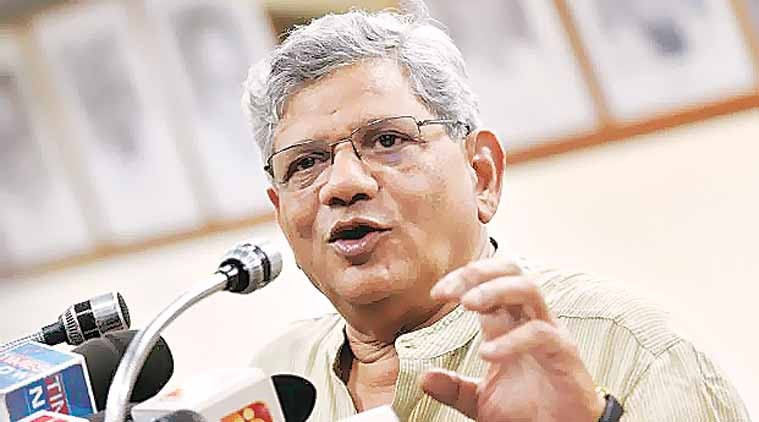
If the exit polls are to be believed, the Left front is likely to witness its worst performance in history in the just concluded Lok Sabha elections, facing a near wipeout in West Bengal -- a bastion it fiercely guarded for more than four decades. A severe leadership crisis, cadres shifting camps and a steady erosion of its vote bank are the key factors that seem to have caused a big dent in the party’s popularity.
The Left Front, which ruled West Bengal for 34 years (1977–2011), is today struggling for its existence as the BJP emerges as the main opposition force in the state. Most of the CPI (M) cadres either switched to the TMC or BJP this election.
In the 2014 general elections, too, the CPI (M) won only two of the 42 Lok Sabha seats in the state -- Raigunj by Mohammad Salim and Murshidabad by Badaruddoza Khan. The party had tried to come up with a pre-poll strategy by teaming up with the Congress but the seat-sharing deal with failed at the last moment and both the sides decided to go solo.
The Left Front managed to win a mere 10 seats, six from Kerala and two each from Bengal and Tripura in 2014. In Tripura, too, it suffered a major debacle as Manik Sarkar lost power after 25 years of being in power. The party won just 16 out of the 59 assembly seats.
The total vote share of CPI (M), Revolutionary Socialist Party (RSP), Communist Party of India (CPI) and Forward Bloc went down from nearly 7.1 per cent in 2009 to 4.4 per cent in 2014 Lok Sabha polls.
Speaking to News18, CPI (M) politburo member Hannan Mollah admitted that it was the party’s time-worn ideology that forced leaders to quit.
“Our cadres left due to our old ideology. We failed to update our ideology and vision for the next generation. Lack of leadership and wrong policies on the ground level added to our woes. These are the issues which led to a steady erosion of our vote bank. In the last 10 years, we failed to do much to re-emerge,” Mollah said.
“Those who were once the red flag carriers of the party are today flaunting saffron or Mamata’s Trinamool symbol. They did so because they see no future in the Left. This makes the party weaker today. In any political party, it’s the workers who make it a strong organisation at the booth level. This time the people of Bengal have decided to embrace a strong Hindutva party rather than opting for Mamata Banerjee’s soft Hindutva. The BJP capitalised the Hindus living in bordering areas who came from erstwhile East Pakistan. This is why the BJP fought the battle here on religious lines and NRC,” he added.
The CPI (M) had over 2.65 lakh members in West Bengal but it dropped further in 2017 after the party, instead of organising fresh trainings, decided to cancel the membership of nearly 15 to 20% inactive cadres. This was reflected in these general elections when the party failed to provide polling agents in nearly 25 per cent of the booths.
Also, the present Left Front does not have the leadership qualities of Jyoti Basu, Buddhadeb Bhattacharya, Somnath Chatterjee and Biman Bose, Harkishan Singh Surjeet and EMS Namboodiripad.
However, CPI (M) leader Sujan Chakraborty, claimed that it is impossible to wipe out the Left from the state and blamed Mamata Banerjee for the saffron surge. “No one can wipe out the Left from Bengal. It is not possible because we have not made any blunders in the last 10 years and whatever is happening today is only because of Mamata Banerjee. It is because of her that BJP managed to fight the elections on religious lines. This never happened in Bengal earlier. We are sure that people will realise their mistake soon.”
He added, “I don’t believe completely in the exit polls. We are winning both the existing seats and this time and we are hopeful of increasing our seats in Bengal.”
On whether BJP managed to prove Karl Marx’s statement ‘Religion is the opium of the people’ wrong, Chakraborty said, “I don’t know whether they proved it wrong or not. But yes they managed to polarise votes in the name of religion by tapping the young minds. This was not the case before. This is an important factor to consider.”
Political analyst Kapil Thakur said that it was of end of direct contact between people and the lft leaders that initiated the party’s downfall. “During the 70s, senior Left leaders used to visit/interact with the people in their respective areas/villages. They were known for formidable organisational prowess. Then, the interaction was more and people accepted this gesture wholeheartedly. Over the years, especially during the 80s, the ‘Jan Sampark’ reduced drastically. Earlier, leaders used to visit houses of farmers and villagers but later they started queuing up for their work at government offices.
“Thakur blamed the ‘babu’ culture for damaging the support base and the erosion of vote share of the Left in the late 80s. “Unfortunately, senior leaders failed to come out of this culture till the TMC stormed into power. Holding so much of power for so many years made the leaders complacent and this is what led to party’s decay as most of the cadres switched to BJP and TMC.”


.jpeg)

